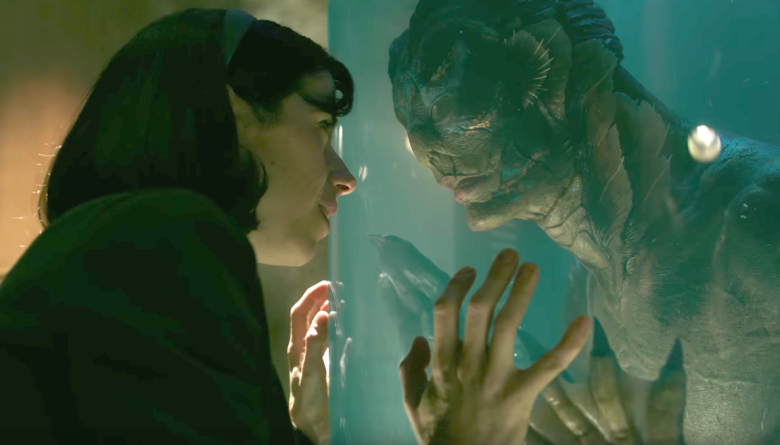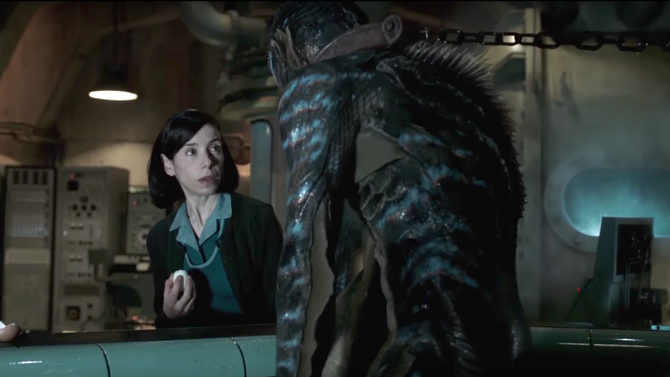#REVIEW The Shape of Water

Those who missed the Mexican-born-Toronto residing filmmaker Guillermo del Toro’s newest directorial offering The Shape of Water at this September’s Toronto International Film Festival will have a second chance to catch the sci-fi/romance/cold-war-thriller on the big screen this Friday. And if you happen to fall into this category, it’s a chance you shouldn’t pass up. Del Toro delivers a gem with The Shape of Water that can confidently stand among the filmmaker’s greatest works. True to the style that he has crafted through the years and over the movies he’s made, The Shape of Water blends a variety of genres and tones, constantly (and seamlessly) switching back and forth between them all, to concoct a moving romance that will have you gagging at one moment and tearing up the next. And of course, it all centers around another kick ass del Toro monster.
The synopsis alone should serve as enough to get the most hesitant of moviegoers into the cinema for this one. A middle aged mute woman working on the custodial staff of a covert government laboratory falls in love with a fish-man monster being kept in the facility and decides to smuggle the creature out to free him from the abusive environment. However, as intriguing a summary as this may sound it sheds but a small flicker of light on what The Shape of Water has to offer. Rather, the shape shifting nature of the film and the surprisingly poignant love story set up through this process are the key takeaways. The film establishes itself as a fairytale of sorts embodying a dreamlike quality, achieved in no small part by Alexandre Desplat’s immaculate score. This tone works as the backbone throughout and serves as the thread that explores the romance between woman and creature. Played against this, however, are dispersed sections of genuine horror (or more accurately grotesquery), suspense and sorrow. These often come without warning, thus augmenting their affect. Similarly, when we return to the fairytale core, in stark contrast to the intensity of what’s going on around our central characters their story becomes all the more heartwarming. If you squint just right you can almost see Guillermo pulling the strings, manipulating us into shock and awe. But what exciting strings to have pulled. I honestly can’t remember the last time I cared so much for a screen couple and also saw a man rip off his own fingers for intimidation effect during an interrogation, in the same runtime.

Sally Hawkins plays Elisa Esposito, the woman in question, with brilliance, bringing a rich depth with every gesture and expression to her wordless character. Not being able to speak Elisa is alienated from the world and those around her. One of the only positive aspects of her life is her friendship to Giles (Richard Jenkins), an out of work homosexual artist that lives next door. We are shown, through repetition of events, the painful triviality of each of the lives they lead. Melancholy seeps through the celluloid as every day Elisa wakes up, pleasures herself alone and goes of to another monotonous shift of moping floors and cleaning bathrooms, while Giles returns to the same pie shop day in day out trying to seduce a server who does not share his orientation. The pain of their existence is palpable but works to ignite the passion of the relationship between Elisa and the creature (Giles plays his part in this), which might otherwise come across as unsettling, when they are shaken from their routine existences.

In addition to adding a Russian spy plot to expedite the story, the 60’s cold war era backdrop provides a wonderful aesthetic to the film. Compared to laboratory’s of the modern day which, if the film was based in present time, would have probably looked like something out of Ridley Scott’s Alien, white, high tech and pristine, those in The Shape of Water are constructed of dark desolate concrete walls and dingy tiled floors, providing a rugged and harsh look and feel. More than the visuals, however, the time period serves as a great tool to stack even more against our main characters. Giles is a homosexual in the 60’s, a time not very understanding of his way of life. Zelda Fuller (Octavia Spencer), Elisa’s best friend at work, who also helps to facilitate the central romance, is an African American woman and no stranger to racism. The head of security for the lab makes blatant advances towards Elisa, figuring her to be weak and powerless to him. This all culminates in the unorthodox love between Elisa and the creature flourishing all the more, standing in the face of the repressions that the two lovers, and those who’ve helped make the relationship happen, face.
Guillermo del Toro is a man who knows the art of film inside and out. The Shape of Water is also a bit of a love letter to golden era Hollywood, with classic films being played within the movie (Elise lives above a cinema and several great moments make use of it) and classic movie songs used as the film’s actual soundtrack. Specifically, however, del Toro is a man who knows monster movies inside and out, and more importantly what makes the good ones work. The story of a woman creature romance is nothing new to the big screen, but The Shape of Water tells the tale with a poetry that’s wholly original. As mentioned, those who missed the film at TIFF this year should jump on the chance to finally check it out, but I suspect that many who were lucky enough to catch it at this year’s festival may just be going back for a second time.
Fox Searchlight releases The Shape of Water in theatres Friday, Dec 8, 2017

